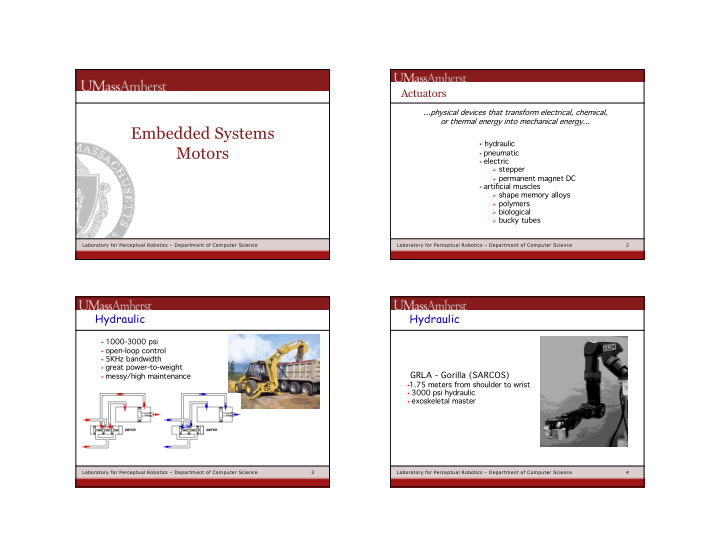



Actuators …physical devices that transform electrical, chemical, or thermal energy into mechanical energy… Embedded Systems • hydraulic Motors • pneumatic • electric Ø stepper Ø permanent magnet DC • artificial muscles Ø shape memory alloys Ø polymers Ø biological Ø bucky tubes Laboratory for Perceptual Robotics – Department of Computer Science Laboratory for Perceptual Robotics – Department of Computer Science 2 Hydraulic Hydraulic • 1000-3000 psi • open-loop control • 5KHz bandwidth • great power-to-weight GRLA - Gorilla (SARCOS) • messy/high maintenance • 1.75 meters from shoulder to wrist • 3000 psi hydraulic • exoskeletal master Laboratory for Perceptual Robotics – Department of Computer Science 3 Laboratory for Perceptual Robotics – Department of Computer Science 4
Hydraulic - Jumping Spiders Pneumatic • pneuma 300 BC - animal spirits • 60-100 psi • jet-pipe servo valves • passively backdrivable • delicate • spiders cannot extend their legs by activating muscles alone --- they generally have less developed extensor musculature • blood acts as hydraulic fluid---BP is very high compared to other insects and animals • special valves and muscles compress their forebodies and act as hydraulic actuators for their legs. Laboratory for Perceptual Robotics – Department of Computer Science 5 Laboratory for Perceptual Robotics – Department of Computer Science 6 Pneumatic - McKibben Air Muscles Electric Motors - Stepper • precise open-loop • low torque • resonance (50-150 steps/sec) • cogging • stroke about 40% of free length • 0-60 psi • power-to-weight up to 100:1 • backdrivable • easily packaged • relatively slow Laboratory for Perceptual Robotics – Department of Computer Science 7 Laboratory for Perceptual Robotics – Department of Computer Science 8
Electric Motors - Permanent Magnet DC Electric Motors - Commutation Lorentz force • back emf • commutation Laboratory for Perceptual Robotics – Department of Computer Science 9 Laboratory for Perceptual Robotics – Department of Computer Science 10 Electric Motors - Permanent Magnet DC Electric Motors - Gearboxes • cheap reliable • cogging • big torques • good power-to-weight • continuous operation • high speeds iron core surface wound moving coil Inertia of load can be dominated by the inertia of the rotor Laboratory for Perceptual Robotics – Department of Computer Science 11 Laboratory for Perceptual Robotics – Department of Computer Science 12
Interfacing Electric Motors Artificial Muscles Me Mechanical properties : elastic modulus, tensile • reversing polarity strength, stress-strain, fatigue life, thermal and • terminals floating - freewheel electrical conductivity • terminals shorted - brake • switches are opened and Th Thermodynamic issues : efficiency, power and force density, power limits closed at different rates and durations to supply different RMS voltages - pulse width Pa Packaging ng : power supply/delivery, device modulation (PWM) construction, manufacturing, control, integration Laboratory for Perceptual Robotics – Department of Computer Science 13 Laboratory for Perceptual Robotics – Department of Computer Science 15 Artificial Muscles - Shape Memory Alloys Artificial Muscles - New Technologies Chemical po Ch polymers - gels (Jello, vitreous humor) Nickel Titanium - Nitinol 1000 fold volume change ~ temp, pH, electric fields • • crystalographic phase transformation from Martensite force up to 100 N/cm 2 • to Austenite 25 um fibers -> 1 Hz, 1 cm fiber -> 1 cycle/2.5 days • • contract (when heated) 5-7% of length - 100 times El Elec ectroa oactive ve pol olymer ers greater effect than thermal expansion store electrons in large molecules • relatively high forces • change length of chemical bonds - batteries/capacitors • about 1 Hz • deform ~ V 2 • Laboratory for Perceptual Robotics – Department of Computer Science 16 Laboratory for Perceptual Robotics – Department of Computer Science 17
Artificial Muscles - New Technologies Bi Biol olog ogica cal Muscl cle Prot oteins actin and myosin • 0.001 mm/sec in a petri dish • Fullerenes an Fu and Nan anotubes • graphitic carbon • high elastic modulus -> large displacements, large forces • macro-, micro-, and nano-scale • extremely robust • potentially superior to biological muscle Laboratory for Perceptual Robotics – Department of Computer Science 18
Recommend
More recommend